Our Saints at Albertus Magnus College
St. Dominic
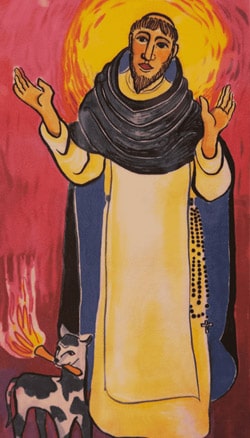
Created by Sr. Thoma Swanson, O.P.
(1170 - 1221)
St. Dominic: Founder of the Dominican Order
Albertus Magnus College is a Catholic College in the Dominican tradition since it was founded by the Dominican Sisters of Peace. The Dominican Order or the Order of Preachers was founded by Dominic in 1206.
Dominic was born in 1170 in Caleruega, Spain. As a young man he was drawn to a life of prayer, study and compassionate service. In order to respond to the heresy of his day, Dominic founded a religious community to preach the Gospel in 1206. Today there are members of the Dominican family on every continent who through their ministries bring the Good News of the Gospel to people world-wide. Dominic died on August 6, 1221. He was made a saint of the Church in 1234.
Today we see the spirit of St. Dominic alive at Albertus Magnus College through the commitment of the College to promote Dominic’s values: study, community, service and spirituality.
St. Albert
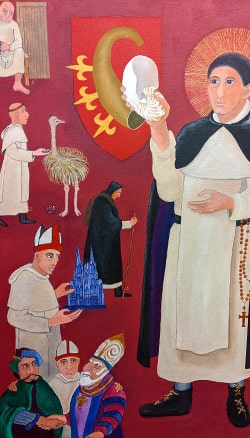
Created by Sr. Thoma Swanson, O.P.
(~1200 - 1280)
St. Albert the Great: The college’s namesake
Patron of Albertus Magnus College, Albert was born about 1200 into the family of the counts of Bollstadt at Lauingen in Swabia. After studying in Bologna and Padua, he entered the recently founded Dominican order in 1223. For the next three decades, he studied and taught in Paris and Cologne, where the young Thomas Aquinas was among his students. In 1254, Albert was elected prior provincial of Germany and, soon after, was appointed papal theologian and named Bishop of Ratisbon. As Bishop he became known as “Boots the Bishop” since he walked everywhere to see those he ministered to as Bishop.
Yearning for academia, he resigned his episcopal appointment in 1262 and returned to Cologne for a life of prayer and study. Albert died in Cologne in 1280. According to a contemporary, Albert was a man “so superior in every science that he can fittingly be called the wonder and miracle of our time.” His encyclopedic writings include works on physics, geography, astronomy, chemistry, biology, philosophy and theology. A listing of his works can be found on the water wall in the Tagliatela Academic Center.
He was a major figure in introducing Aristotle to the Latin West and was instrumental in the acceptance of human learning as an essential handmaid to theology. In 1933, Albert was proclaimed a saint and doctor of the Church.
Catholic Encyclopedia Biography of St. Albert
Full Text of St. Albert’s On Union with God
St. Catherine of Siena
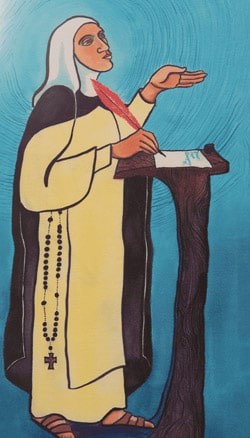
Created by Sr. Thoma Swanson, O.P.
(1344 - 1380)
St. Catherine of Siena: Doctor of the Church
One of the great women saints of the Dominican Order is Catherine of Siena. Catherine was born in 1344 in Siena, Italy. Although Catherine had no formal education as a child she left us her Prayers, Letters and Dialogue (with God).
Catherine joined the Dominican Mantellate, a group of Dominican lay women at the age of 18. Although she spent a great deal of time in prayer she also had and active life of service as a spiritual guide to others, as a pastoral presence to the suffering and as a peacemaker and reformer. Some of the major themes of her writings are the pursuit of truth, love and compassion for one’s neighbor, peace, the spiritual life and following the will of God. Catherine died on April 29, 1380. She was made a saint of the Church in 1461 and proclaimed a doctor of the Church in 1970.
Today at Albertus Magnus College we look to Catherine for inspiration as a person who was close to God, compassionate to others and courageous in her willingness to speak the truth to injustice.
Letters of Catherine Benincasa (St. Catherine of Seina) on Gutenberg.org
St. Thomas Aquinas
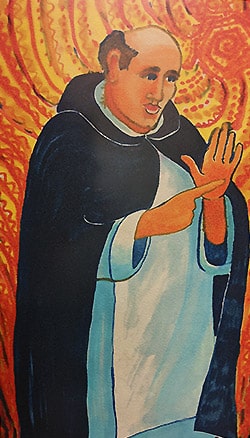
Created by Sr. Thoma Swanson, O.P.
(1225 - 1274)
Dominican St. Thomas Aquinas was a philosopher, theologian and later named a Doctor of the Church. In his writings Thomas emphasized the complementarity of faith and reason as God is the source of both faith and reason. Thomas studied under St. Albert the Great, the patron of the college, and like Albert studied other philosophers such Aristotle.
His major works are the Disputed Questions on Truth, the Summa Contra Gentiles and
the unfinished Summa Theologica. These works are still studied by students of theology
today. In addition to his theological works Thomas also wrote Eucharistic hymns that
are still used in worship today. Albert once said of his student Thomas, who was being
ridiculed by some of his fellow students, you can call him the dumb ox, but in his teaching he will one day produce such a bellowing
that it will be heard throughout the world.
Some of the themes captured in his writings are ethics, political order, justice, economics, revelation, grace, creation, just war, nature of God, the Trinity, sin, Jesus Christ, and resurrection.
St. Rose of Lima
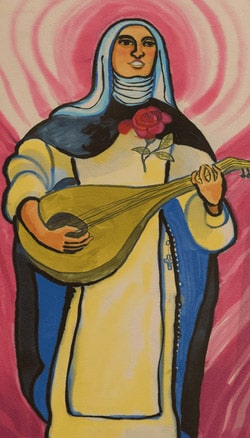
Created by Sr. Thoma Swanson, O.P.
(April 20, 1586 - August 24, 1617)
St. Rose was a Dominican lay women who was born in Lima, Peru where she was known for her ministry to those in need and her deep spirituality. She often brought the sick and hungry to her room where she could feed and care for them. Rose was also known for her fine needle work and the flowers she grew and sold to help others.
A woman of deep prayer, Rose spent hours in contemplation and prayer. Rose died at the age of 31 and there is a tradition that says Lima smelled like roses and roses fell from the sky after her death. Rose was recognized a saint on April 12, 1671 and is the Patroness of the Americas, the indigenous people of the Americas and Peru. Her feast day is on August 23.
St. Martin De Porres
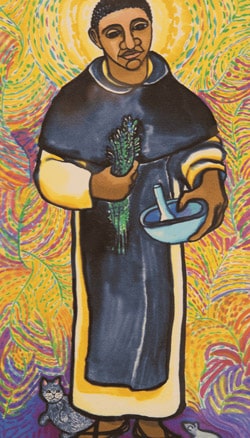
Created by Sr. Thoma Swanson, O.P.
(December 9, 1579 - November 3, 1639)
St. Martin De Porres was a Dominican lay brother who was born in Lima, Peru. He was indigenous son of a Spanish nobleman and a freed slave of African and native descent. Martin grew up in poverty and was trained to be a barber/surgeon.
At the age of 15 he entered the Dominicans. He was known for his compassion as he practiced his trade, became known as a healer, cared for the poor and sick, and animals. In addition he founded a residence for orphans and abandoned children in Peru. Martin’s mercy for all was strong and was strengthened by his life of prayer. Martin was proclaimed a saint on May 6, 1962. His feast day is celebrated on November 3.
Martin is the patron of those seeking harmony, innkeepers, barbers and public health workers.
St. Fra Angelico
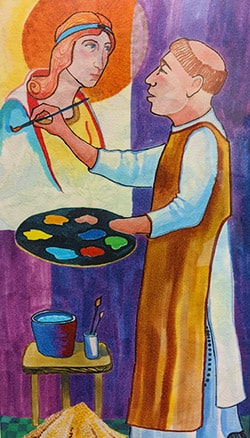
Created by Sr. Thoma Swanson, O.P.
(~1395 - February 18, 1455)
Fra Angelico, a Dominican artist, was known to his community as Brother John of Fiesole. He received the special title of Fra Angelico because of the angels that were featured in his art work.
Known for the holiness of his life and his paintings, especially at his priory, San Marco, in Florence, Fra Angelico captured in his works the life of Jesus from the Gospels and the life of St. Dominic, founder of the Dominican Order.
>Fra Angelico was proclaimed a saint in 1982 and his feast day is celebrated on February 18. He is the patron of artists.
